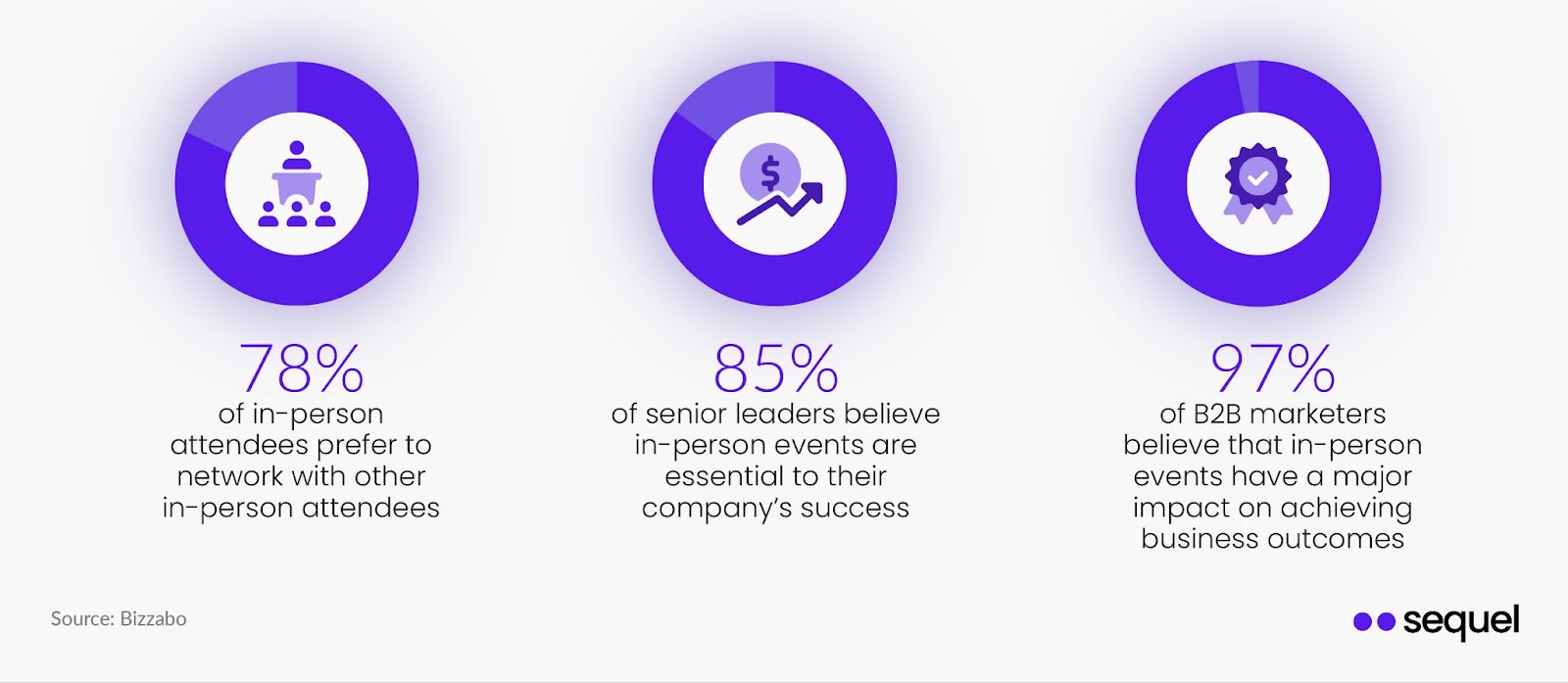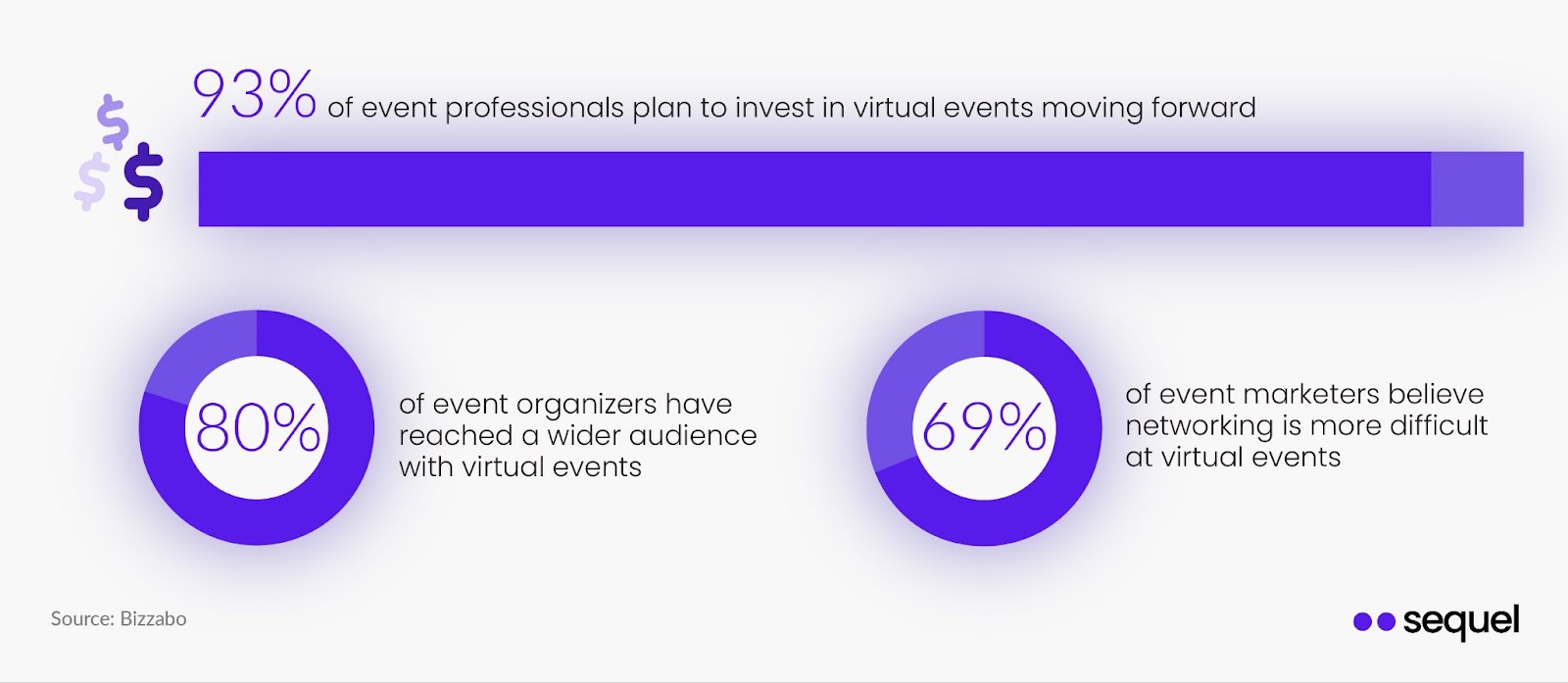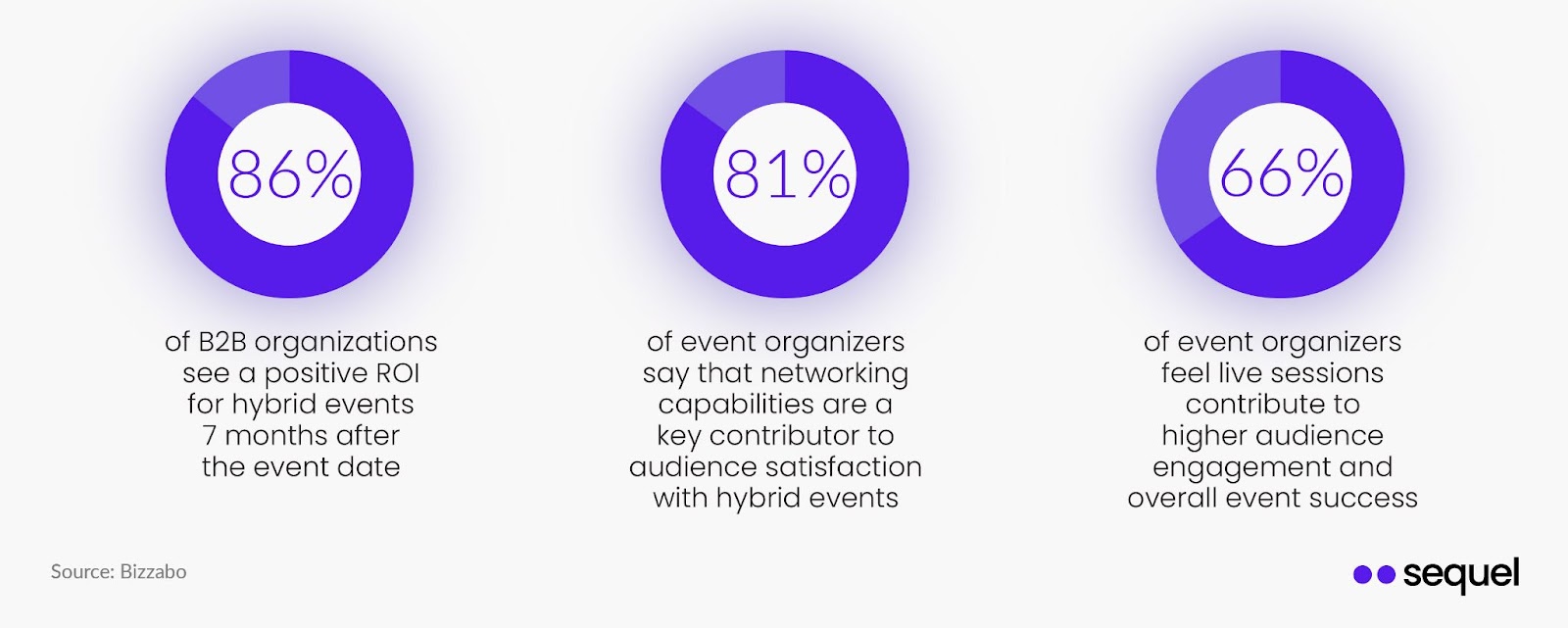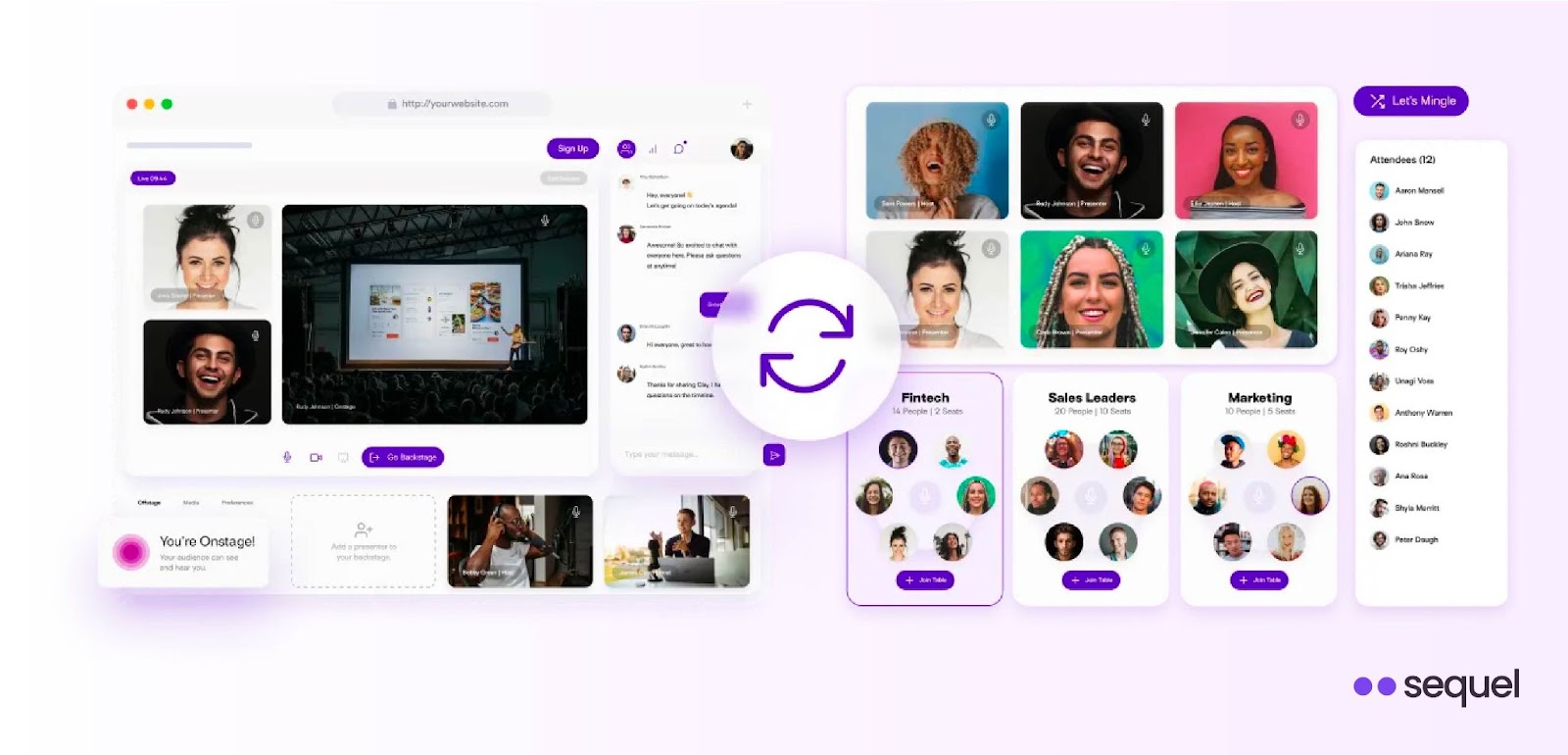Live Vs. Hybrid Vs. Virtual Events: How to Choose the Best Option
As the business world continues to recover from the pandemic, event planners face a challenge as they try to strike a balance between different types of events. According to a 2021 poll by Qualtrics, 59% of respondents said they prefer virtual conferences, and 41% said they will still choose to attend a virtual event in 2022. Ongoing uncertainty about health and travel means that for many organizations, virtual events will be an option for quite some time.
But that’s only half the story. As in-person events return, many organizations are considering hybrid events that combine the in-person engagement of live events with the audience reach and interactivity of the best virtual events. In a 2022 survey by Markletic, over half of businesses with more than 500 employees said they planned to include hybrid events in their portfolios.

Although it’s tempting to chalk the growth of hybrid events up to organizations hedging their bets against uncertainty, there’s another key element at play here. The digital tools and apps that make virtual conferencing so effective are also useful for increasing audience engagement at in-person events, even if those events don’t offer a virtual component. Event attendees expect to engage with events when, where, and how they want. To reach your event goals, you need to remove barriers to access and let attendees get the most out of the event, whether they are attending in-person or virtually.
This article will help you find the right balance between event types to grow audience engagement, reach your event goals, and give attendees the best event experience.
The Advantages of Live, Hybrid, and Virtual Events
The past few years have seen huge changes in the event world. Technology has blurred the lines between event formats and how attendees engage with events and each other. Understanding how the different event types stack up can help you mix and match the best the three types of events have to offer to reach your event goals.
Physical Events
Physical events are one of the most powerful ways to build connections and generate excitement around a product, service, or brand. When The LEGO Movie was nominated for the Academy Award for best song in 2015, performers gave out LEGO Oscar statuettes to celebrities in the audience. The giveaway resulted in almost 47,000 social mentions and approximately $7.5 million in free advertising for the company.
Live and in-person events are held in a physical location and feature live speakers and exhibitors. They also remain the most popular type of event, with 69% of event attendees saying they want to return to in-person events as the world moves out of the pandemic.
The main advantage of in-person events is networking. Live events like trade shows are ideal for building and deepening business connections and creating a feeling of shared experience. On the other hand, in-person events can be expensive and logistically challenging, especially in light of ongoing health and safety concerns. The return to in-person events has been slow: a study of 8227 marketers worldwide reported that only 35% of events in 2022 will be in person. It may be some time before attendance numbers for in-person events reach pre-pandemic numbers.

Virtual or Online Events
Virtual or online events use a virtual event platform to connect attendees and speakers remotely. They remain the most popular type of event as the world recovers from the pandemic. According to Statista, 40% of events in 2022 will be virtual experiences.
The primary advantages of virtual events are that they are low-cost and easy to implement, they can reach large potential audiences, and they’re safe. On the downside, networking during many types of virtual events can be challenging due to Zoom fatigue and non-participation.

Hybrid Events
Hybrid events combine in-person and virtual elements and experiences in real-time for in-person and virtual attendees. In 2021, 56% of companies with 500-1000 employees said they have hybrid events in their portfolio. In the same survey, companies with over 5000 employees reported that 71% of their events were hybrid.
Hybrid events are attractive because they allow attendees the greatest flexibility in how they choose to attend an event. They also combine the best elements of the in-person event experience with the integration of virtual engagement and interaction tools.

Four Things to Consider When Choosing The Type of Event
There are four main factors to consider when choosing what type of event will help you achieve your event goals and maximize the ROI of your upcoming events.
1. Who are Your Attendees?
Who are your target attendees, and how likely are they to attend an in-person event? According to Qualtrics, only 12% of people surveyed in 2021 said they would travel internationally for an in-person event, but 43% said they’d travel within their country of residence. If you are considering an in-person event, would you be able to attract enough attendees to make the event profitable? If not, a virtual or hybrid event may be a better option.
Is networking the primary goal of your event? If so, you should consider an in-person or hybrid event, as 93% of attendees agree that in-person events provide the best opportunities for building business connections.
2. What’s Your Event Format?
What type of energy does your event need to be successful? The format of your event can drive the kind of event you choose. Does your event require physical attendance, or can it be hosted virtually? You should consider a live or hybrid format if your event hinges on something high-energy and high-touch, like giving out LEGO Oscar statuettes. If you’re delivering courses for professional certification, you may want to look at a webinar, as 80% of people use virtual conferencing for educational purposes.
3. What’s the Business Case for your Event?
Your audience and format are major factors in deciding what type of event to offer, but ultimately it all comes down to return on investment. To be sustainable, events must provide a positive investment return and deliver on their goals. The type of event you choose will have a significant impact on ROI. Consider your goals, costs, and logistics carefully, and identify your event’s core revenue streams, then pick the format that works best for your business case. For example, faced with continued uncertainty over travel and in-person events, SXSW adopted a hybrid format for 2022 to allow attendees to experience the event virtually and on-demand.
4. How Will You Build Attendee Engagement?
In a 2019 survey, 90% of event marketers reported that providing a personalized event experience was important, and 70% reported tracking attendee engagement and satisfaction as a KPI for event success. 63% of respondents said they believed tools to engage virtual attendees would play a key role in their future event strategies. When the pandemic forced Techstars, the leading platform for entrepreneurial mentorship and innovation, to move its Accelerator programs and Demo Days to a virtual program in 2020, they leveraged Sequel’s technology to allow them to livestream speakers and engage attendees. As a result, attendees could interact and build connections with investors, mentors, alumni, and stakeholders organically in real-time and post-event.
Digital Engagement is Crucial for Engaging Audiences
Simon’s Heart is a non-profit organization dedicated to raising awareness about and preventing sudden cardiac arrest in children. Each year, the non-profit relies on an annual gala, “Simon’s Soiree,” as its primary fundraising event. When the pandemic forced Simon’s Heart to cancel the in-person gala, they needed to find a way to move the Soiree to a virtual event. Their challenge was to ensure that the virtual event engaged donors and sustained the funding Simon’s Heart needed to continue its work.
Sequel worked with Simon’s Heart to create a virtual gala experience that would engage donors. The main program took place on Sequel’s Virtual Stage, complete with guest appearances from the audience and keynote presentations from community members and beneficiaries of Simon’s Heart’s life-saving mission. After the main program, attendees transitioned seamlessly into Sequel’s Networking Hub, which was set up as an “afterparty” space. Guests networked, collaborated and even hosted a concert where attendees jammed with the house band. The event was a success: Simon’s Heart raised $250,000 – double what the organizers expected – and in line with donations from the previous in-person galas.
The event experience needs to be tailored to in-person and virtual audiences to engage attendees. That means you need two things: to understand both audiences’ expectations and a solution that has the functionality to deliver on those expectations. In this context, digital engagement is especially important for maintaining and expanding the audience reach of events. Virtual engagement also keeps events accessible to attendees who can’t attend in person due to travel restrictions or disability or health concerns. For Simon’s Heart, succeeding at engaging virtual attendees meant they could continue to fund their mission for another year.
Sequel: Seamlessly Engage Live and Virtual Attendees

Sequel is the world’s only embeddable solution that provides your organization with powerful pre-built live event components, such as Hybrid and Virtual Stages, chat, and Networking Hub. Sequel can be embedded anywhere to create a seamless event experience – from custom conferences, series of events, and career fairs to virtual offices and town halls.
Sequel supports up to 2 million concurrent viewers, has high-quality 4K video, and has a vast suite of engagement features, making it a perfect solution for live events of all magnitudes. Sequel powers customers like Comcast, Wharton, Barclays, and more. Sequel empowers powerful engagement features such as reactions, breakout sessions, live polls, forums, Q&A, social media interaction, and networking hubs to encourage interactions with both live and virtual audiences.

Request a demo to see how we can help you get the most out of your next virtual event.